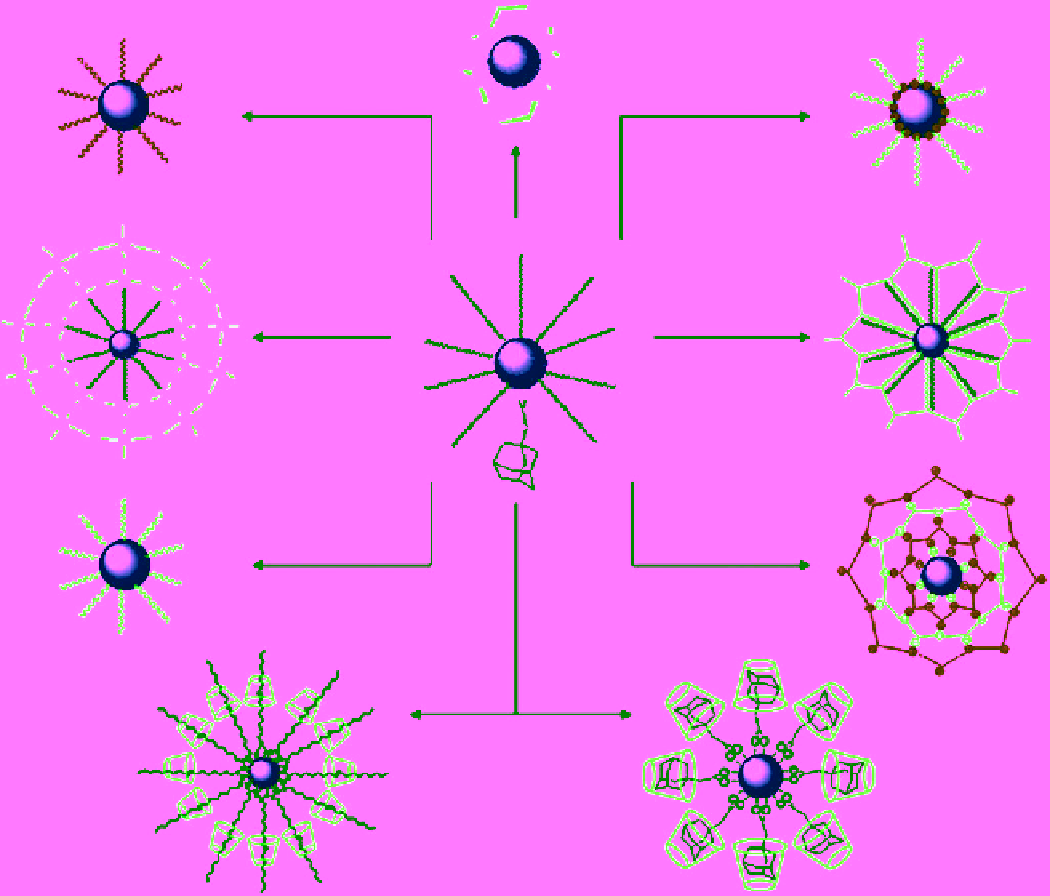Chemistry Reference
In-Depth Information
H
O
H
O
H
H
O
H
O
H
Ligand exchange
Cation-assisted
ligand assembly
Ligand
free
Si
O
O
O
Si
O
Si
O
Si
O
O
O
Si
Si
O
O
O
Si
O
Si
OSi
Si
O
O
O
O
Silanisation
Hydrophobic-
hydrophobic
interaction
Si
Si
O
O
Si
Si
O
Si
O
O
O
O
-
Si
O
O
O
O
O
Si
O
Si
Si
O
Si
O
Ligand
oxidation
Layer-by-layer
Host-guest
interaction
α
-CD
β
-CD
Scheme 13.2
general strategies to modify the surface properties of Ln-UCNPs [5].
groups then point outward to form a hydrophilic layer. oA-PAA-PEg [52], CTAB, anionic AoT, and nonionic PEg
tert
-octylphenyl ether [53] have been shown to serve as amphiphilic molecules to achieve this goal.
A layer-by-layer assembly method is another route to construct a hydrophilic surface. Li and co-workers have used poly-
electrolytes, such as PAH and PSS deposited on the surface of Ln-UCNPs [54]. Due to the repulsion between charges of the
same kind, only one layer of polyelectrolytes can be deposited on the Ln-UCNPs at a time. The alternate usage of negative
and positive polyelectrolytes will result in the layer-by-layer assemblies. Thus, the size of the assembled NPs can be con-
trolled accurately.
Host-guest interaction is another force to enable the effective assembly of ligands. Li and co-workers developed an
efficient method to draw oA-coated Ln-UCNPs into water by introducing
alpha
-cyclodextrin as the host to interact with
oA (guest) molecules [55]. A similar method is also used for the adamantaneacetic acid-capped Ln-UCNPs, using
beta
-
cyclodextrin instead of
alpha
-cyclodextrin.
The last but perhaps most important method is the silanisation of Ln-UCNPs. This protocol is the easiest one and gives
the best flexibility to link Ln-UCNPs with biomolecules. To date, a series of silanisation methods have been developed for
Ln-UCNPs with various surface ligands. Ln-UCNPs with hydrophilic capping ligands can be directly coated by silica via
the common Stöber method; therefore, the abovementioned products can all be coated with a silica shell after transitioning
to the hydrophilic surface [56]. The thickness of the silica shell can be controlled by the ratio of TEoS and Ln-UCNPs.
Reverse microemulsion systems can be used to obtain a silica shell outside the hydrophobic Ln-UCNPs [57]. Typically,
polyoxyethylene 5-nonylphenylether, branched (Igepal Co520) is used as a surfactant to form the microemulsion. Ln-UCNPs

